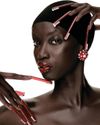
When, one night in Manhattan, 1964, Truman Capote accepted a ride in Richard Burton and Elizabeth Taylor’s limousine after the theater, the author wasn’t prepared to find himself at the center of a mob scene. “Damp, ghostly faces were flattened against the car’s windows,” he wrote. “The whole scene was like a stilled avalanche nothing could budge.” The crowds would gather the following evening, and the one after that, too; Burton, fresh from starring alongside Taylor in Cleopatra, had signed on to play Hamlet for 17 weeks on Broadway, and pandemonium raged outside the Midtown theater.
It’s this fraught Shakespeare production—led by Burton, directed by West End titan John Gielgud, and underwritten by Taylor’s tangential involvement—that has inspired director Sam Mendes’s The Motive and the Cue, opening at the Lyttelton Theatre in London this spring. It marks the Oscar winner’s first return to the stage since 2018’s The Lehman Trilogy.
“For me, The Motive and the Cue tries to find answers to three questions,” Mendes reflects. “Why would the era’s biggest movie star—Richard Burton—want to spend his honeymoon playing a role which has already been played by thousands of actors, while his new wife—Elizabeth Taylor—sits in a hotel room waiting for him to return? Why do we go back to these plays over and over, and what is the point of classical theater at all? What goes on in a rehearsal room when you make theater, and— if there is conflict—is that really such a bad thing?”
This story is from the {{IssueName}} edition of {{MagazineName}}.
Start your 7-day Magzter GOLD free trial to access thousands of curated premium stories, and 9,000+ magazines and newspapers.
Already a subscriber ? Sign In
This story is from the {{IssueName}} edition of {{MagazineName}}.
Start your 7-day Magzter GOLD free trial to access thousands of curated premium stories, and 9,000+ magazines and newspapers.
Already a subscriber? Sign In

FINAL CUT
\"WE WANT YOU TO GO FOR IT!\" ANNA TOLD ME

SCREEN TIME
Three films we can't wait to see.

Impossible Beauty
Sometimes, more is more: Surreal lashes and extreme nails put the fierce back in play

Blossoms Dearie
Dynamic, whimsical florals and the humble backdrops of upstate New York make for a charming study in contrasts.

HOME
Six years ago, Marc Jacobs got a call about a house designed by Frank Lloyd Wright. Making it his own, he writes, would be about love, commitment, anxiety, patience, struggle, and, finally, a kind of hard-fought, hard-won peace.

GIRL, INTERRUPTED
Anna Weyant found extraordinary fame as an artist before she had reached her mid-20s. Then came another kind of attention. Dodie Kazanjian meets the painter at the start of a fresh chapter

ROLE PLAY
Kaia Gerber is someone who likes to listen, learn, read books, go to the theater, ask questions, have difficult conversations, act, perform, transform, and stretch herself in everything she does. That she's an object of beauty is almost beside the point.

CALLAS SHEET
Maria Callas's singular voice made her a legend on the stage. In a new film starring Angelina Jolieand on the runwaysthe romance continues.

BOOK IT
A preview of the best fiction coming

GLOBAL VISTAS
Three new exhibitions offer an expansive view.